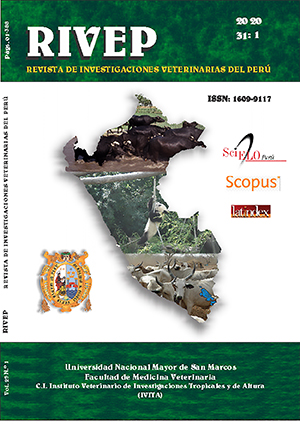Reproductive performance in pig farms seropositive to porcine reproductive and respiratory syndrome virus (VPRRS)
DOI:
https://doi.org/10.15381/rivep.v31i1.17550Keywords:
VPRRS, litter size, gestationAbstract
The present study evaluated the duration of days of gestation (DG) and litter size (LS) in pigs of a seropositive central coast farm and seronegative central tropics farm to Porcine Reproductive and Respiratory Syndrome Virus (VPRRS) during the years 2015 and 2016. Sows from VPRRS-positive farm showed increased DGs and LSs decreased in VPRRS-positive farm compared to those from seronegative tropical farm in 2015. DGs from VPRRS-positive farm pigs were shorter in 2015 compared to 2016. The DG and the LS were not influenced by the time of artificial insemination. Lower DG with higher LS expresses normal reproductive performance and support the seronegative result to VPRRS in tropical farms. Increased LS in positive farm to VPRRS in 2016 with respect to 2015 suggests the development of physiological adaptive processes of sows induced by the presence of the disease due to immunoregulation.
Downloads
Downloads
Published
Issue
Section
License
Copyright (c) 2020 Miguel Edmundo Lucho-Cerga, Hilario Noberto Pujada Abad, Felix Esteban Airahuacho-Bautista

This work is licensed under a Creative Commons Attribution-NonCommercial-ShareAlike 4.0 International License.
AUTHORS RETAIN THEIR RIGHTS:
a. Authors retain their trade mark rights and patent, and also on any process or procedure described in the article.
b. Authors retain their right to share, copy, distribute, perform and publicly communicate their article (eg, to place their article in an institutional repository or publish it in a book), with an acknowledgment of its initial publication in the Revista de Investigaciones Veterinarias del Perú (RIVEP).
c. Authors retain theirs right to make a subsequent publication of their work, to use the article or any part thereof (eg a compilation of his papers, lecture notes, thesis, or a book), always indicating the source of publication (the originator of the work, journal, volume, number and date).










